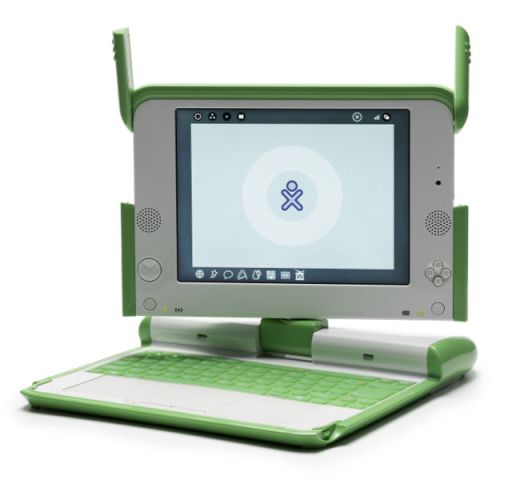Laptop With a Mission Widens Its Audience
By DAVID POGUE
4 october 2007
In November, you’ll be able to buy a new laptop that’s spillproof, rainproof, dustproof and drop-proof. It’s fanless, it’s silent and it weighs 3.2 pounds. One battery charge will power six hours of heavy activity, or 24 hours of reading. The laptop has a built-in video camera, microphone, memory-card slot, graphics tablet, game-pad controllers and a screen that rotates into a tablet configuration.
And this laptop will cost $200.
The computer, if you hadn’t already guessed, is the fabled “$100 laptop” that’s been igniting hype and controversy for three years. It’s an effort by One Laptop Per Child (laptop.org) to develop a very low-cost, high-potential, extremely rugged computer for the two billion educationally underserved children in poor countries.
The concept: if a machine is designed smartly enough, without the bloat of standard laptops, and sold in large enough quantities, the price can be brought way, way down. Maybe not down to $100, as O.L.P.C. originally hoped, but low enough for developing countries to afford millions of them — one per child.
The laptop is now called the XO, because if you turn the logo 90 degrees, it looks like a child.
O.L.P.C. slightly turned its strategy when it decided to offer the machine for sale to the public in the industrialized world — for a period of two weeks, in November. The program is called “Give 1, Get 1,” and it works like this. You pay $400 (www.xogiving.org). One XO laptop (and a tax deduction) comes to you by Christmas, and a second is sent to a student in a poor country.
The group does worry that people might compare the XO with $1,000 Windows or Mac laptops. They might blog about their disappointment, thereby imperiling O.L.P.C.’s continuing talks with third world governments.
It’s easy to see how that might happen. There’s no CD/DVD drive at all, no hard drive and only a 7.5-inch screen. The Linux operating system doesn’t run Microsoft Office, Photoshop or any other standard Mac or Windows programs. The membrane-sealed, spillproof keyboard is too small for touch-typing by an adult.
And then there’s the look of this thing. It’s made of shiny green and white plastic, like a Fisher-Price toy, complete with a handle. With its two earlike antennas raised, it could be Shrek’s little robot friend.
And sure enough, the bloggers and the ignorant have already begun to spit on the XO laptop. “Dude, for $400, I can buy a real Windows laptop,” they say.
Clearly, the XO’s mission has sailed over these people’s heads like a 747.
The truth is, the XO laptop, now in final testing, is absolutely amazing, and in my limited tests, a total kid magnet. Both the hardware and the software exhibit breakthrough after breakthrough — some of them not available on any other laptop, for $400 or $4,000.
In the places where the XO will be used, power is often scarce. So the laptop uses a new battery chemistry, called lithium ferro-phosphate. It runs at one-tenth the temperature of a standard laptop battery, costs $10 to replace, and is good for 2,000 charges — versus 500 on a regular laptop battery.
The laptop consumes an average of 2 watts, compared with 60 or more on a typical business laptop. That’s one reason it gets such great battery life. A small yo-yo-like pull-cord charger is available (one minute of pulling provides 10 minutes of power); so is a $12 solar panel that, although only one foot square, provides enough power to recharge or power the machine.
Speaking of bright sunshine: the XO’s color screen is bright and, at 200 dots an inch, razor sharp (1,200 by 900 pixels). But it has a secret identity: in bright sun, you can turn off the backlight altogether. The resulting display, black on light gray, is so clear and readable, it’s almost like paper. Then, of course, the battery lasts even longer.
The XO offers both regular wireless Internet connections and something called mesh networking, which means that all the laptops see each other, instantly, without any setup — even when there’s no Internet connection.
With one press of a button, you see a map. Individual XO logos — color-coded to differentiate them — represent other laptops in the area; you connect with one click. (You never double-click in the XO’s visual, super-simple operating system. You either point with the mouse or click once.)
This feature has some astonishing utility. If only one laptop has an Internet connection, for example, the others can get online, too, thanks to the mesh network. And when O.L.P.C. releases software upgrades, one laptop can broadcast them to other nearby laptops.
Power users will snort at the specs of this machine. It has only one gigabyte of storage — all flash memory — with 20 percent of that occupied by the XO’s system software. And the processor is feeble by conventional standards. Starting up takes two minutes, and switching between programs is poky.
Once in a program, though, the speed is fine; it turns out that a light processor is plenty if the software is written compactly and smartly. (O.L.P.C. points out that despite gigantic leaps in processing power, today’s business laptops don’t feel any faster than they did a few years ago. The operating systems and programs have added so much bloat that they absorb the speed gains.)
The built-in programs are equally clever. There’s a word processor, Web browser, calculator, PDF textbook reader, some games (clones of Tetris and Connect 4), three music programs, a painting application, a chat program and so on. The camera module permits teachers, for the first time, to send messages home to illiterate parents.
There are also three programming environments of different degrees of sophistication. Incredibly, one keystroke reveals the underlying code of almost any XO program or any Web page. Students can not only study how their favorite programs have been written, but even experiment by making changes. (If they make a mess of things, they can restore the original.)
There’s real brilliance in this emphasis on understanding the computer itself. Many nations in XO’s market have few natural resources, and the global need for information workers grows with every passing day.
Most of the XO’s programs are shareable on the mesh network, which is another ingenious twist. Any time you’re word processing, making music, taking pictures, playing games or reading an e-book, you can click a Share button. Your document shows up next to your icon on the mesh-network map, so that other people can see what you’re doing, or work with you. Teachers can supervise your writing, buddies can collaborate on a document, friends can play you in Connect 4, or someone across the room can add a melody to your drum beat in the music program. You’ve never seen anything like it.
The pair of laptops I reviewed had incomplete power-management software, beta-stage software and occasional cosmetic glitches. But O.L.P.C. and its worldwide army of open-source (volunteer) programmers expect to polish things by the time the assembly line starts to roll in November.
No, the biggest obstacle to the XO’s success is not technology — it’s already a wonder — but fear. Overseas ministers of education fear that changing the status quo might risk their jobs. Big-name computer makers fear that the XO will steal away an overlooked two-billion-person market. Critics fear that the poorest countries need food, malaria protection and clean water far more than computers.
(The founder, Nicholas Negroponte’s, response: “Nobody I know would say, ‘By the way, let’s hold off on education.’ Education happens to be a solution to all of those same problems.”)
But the XO deserves to overcome those fears. Despite all the obstacles and doubters, O.L.P.C. has come up with a laptop that’s tough and simple enough for hot, humid, dusty locales; cool enough to keep young minds engaged, both at school and at home; and open, flexible and collaborative enough to support a million different teaching and learning styles.
It’s a technological breakthrough, for sure. Now let’s just hope it breaks through the human barriers.
Anders Mogensen, the co-founder of Seismonaut heads to Nigeria to visit the first school testing the laptop. Note the VSAT next to the school:

 For decades, Japan’s scientific whaling program has killed thousands of whales as part of what it calls necessary research.
For decades, Japan’s scientific whaling program has killed thousands of whales as part of what it calls necessary research. Call it serendipity: as members of the satellite industry prepare to attend the
Call it serendipity: as members of the satellite industry prepare to attend the 
 The Soyuz-FG rocket is scheduled to blast off from the Central Asian steppe on Wednesday night to take Malaysia’s Sheikh Muszaphar Shukor, Peggy Whitson of Beaconsfield, Iowa, and Russian Yuri Malenchenko into orbit.
The Soyuz-FG rocket is scheduled to blast off from the Central Asian steppe on Wednesday night to take Malaysia’s Sheikh Muszaphar Shukor, Peggy Whitson of Beaconsfield, Iowa, and Russian Yuri Malenchenko into orbit.



